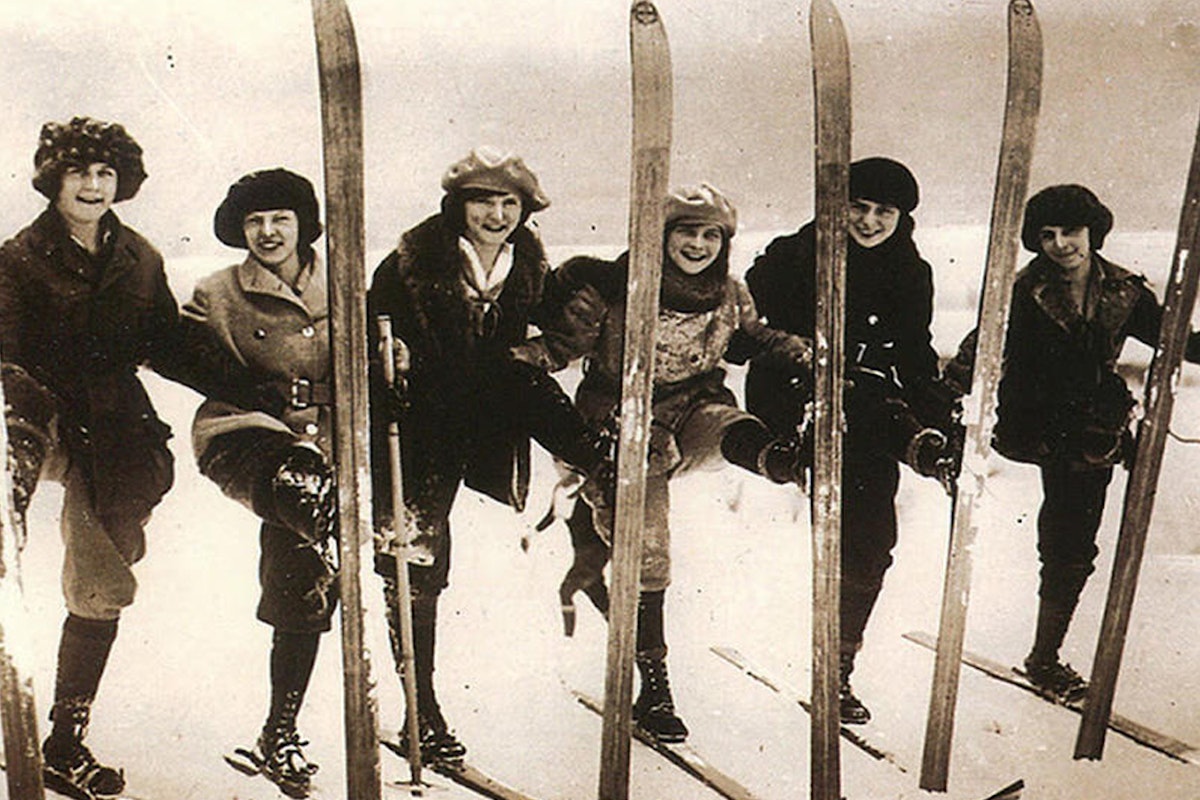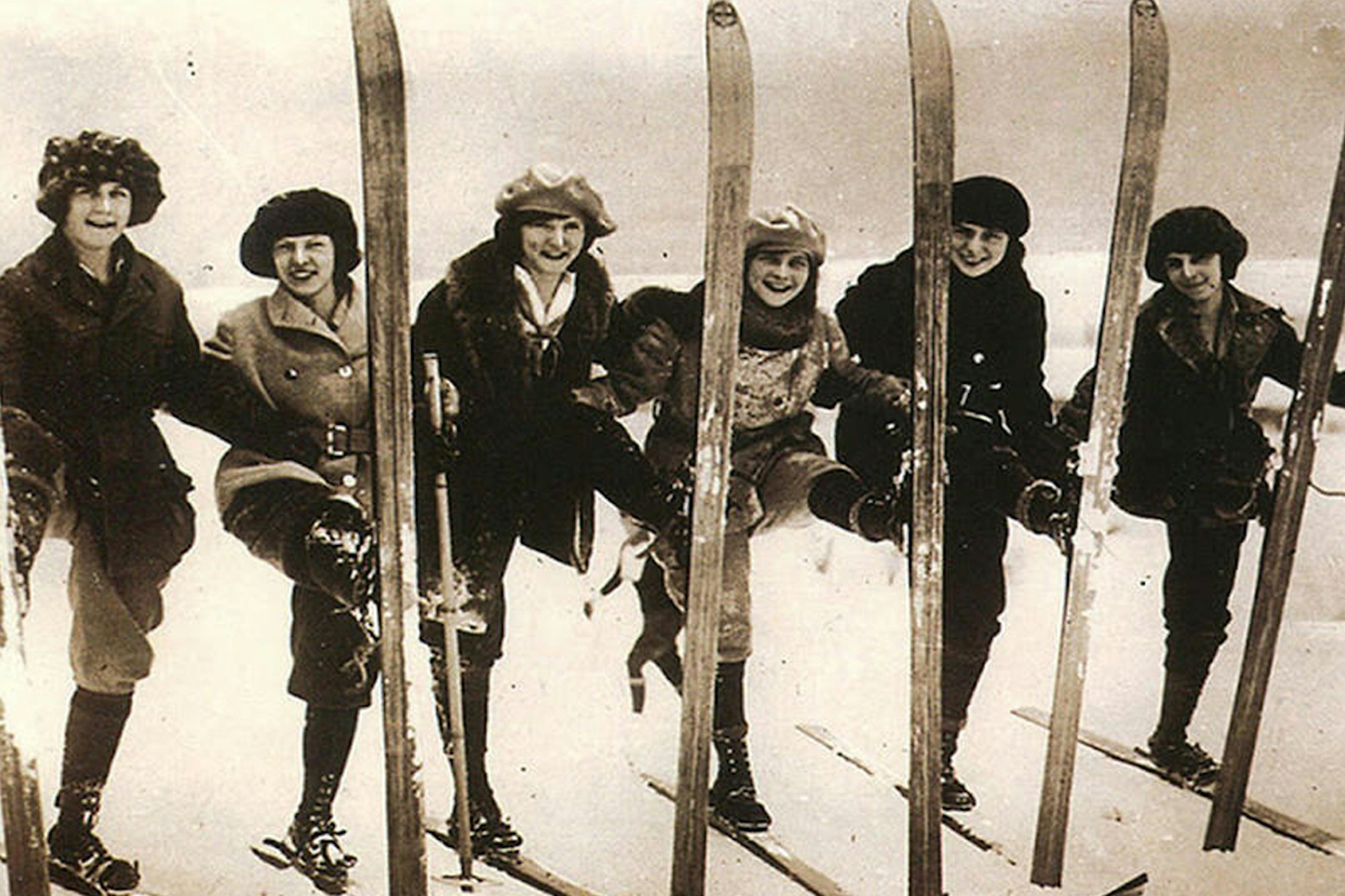Featured Image: Courtesy of History Daily
Rip-roarin’ into 2020, women are absolutely slaying. Whether we’re summiting the steps of Congress or the peaks of the world’s tallest mountains, we’re making our voices heard and intentions known. In light of this kickass female revolution, I decided to highlight some of the baddest bitches in skiing who have significantly influenced the sport for future generations. From leveling competition fields to shrinking the gender gap–both fiscally and socially–these 10 women are freeskiing pioneers. Whoever said skiing like a girl was a bad thing obviously didn’t bear the Venus symbol next to their name.
Suzy Chaffee
You may know her as Suzy Chapstick, but Suzy Chaffee has accomplished a helluva lot more than just a commercial deal in her ski career. Chaffee competed at the 1968 Winter Olympics in Grenoble, France, as a downhill ski racer before hanging up her infamous silver racing suit for freestyle skiing, where she was the World Freestyle Skiing champion from 1971 to 1973. Beyond her own career, Chaffee was, and still is, a huge champion for women’s athletics. She was the first woman to serve on the board of the U.S. Olympic Committee, helped organize the 1984 World Cup event in Breckenridge that qualified freestyle skiing as an Olympic sport and championed the 1972 Title IX legislation, which gives women equal opportunity in college athletics. Chaffee was inducted into the National Ski Hall of Fame in 1988 and continues to live on as a skiing legend.
Kim Reichhelm
Growing up in a family of competitors, Kim Reichhelm stepped into her first pair of skis at the age of three and was competitively ski racing by the time she was five. At 15, Reichhelm was named to the U.S. Ski Team and went on to become a two-time NCAA All American for the University of Colorado. After retiring her race boots, the Vermont native competed in the first-ever World Extreme Skiing Championships in 1990 and is still the only skier to win the South American, U.S. and World Extremes, all in the same year. Following a knee injury that sidelined her for the season and eager to introduce more women to the sport she loved so deeply, Reichhelm started the Women’s Ski Adventure (WSA) organization in 1991. Nowadays, her camps, most notably Ski With Kim, continue to bring skiers together for the sake of having fun sliding on snow.
Kristen Ulmer
From 1990 to 2001, Kristen Ulmer was considered the best female big-mountain extreme skier in the world. Starting out on the U.S. Ski Team for Moguls, Ulmer quickly transitioned to big-mountain pursuits, hucking her meat off of massive backcountry cliffs. In 1997, Ulmer claimed the first female ski descent of the Grand Teton and starred in over 20 ski movies throughout her career. In 2003, Ulmer, feeling burnt out, retired from skiing and started studying with a Zen Master. What she learned was her adamance to ignore fear was destroying her love of the sport. In 2018, Ulmer released her first book, The Art of Fear: Why Conquering Fear Won’t Work and What to Do Instead, to help others understand and harness the power of the emotion. This year, she joined the ranks of skiing’s most notable athletes in the National Ski Hall of Fame.
Alison Gannett
It wasn’t until Alison Gannett was in the thick of her environmental career that the Crested Butte, Colorado-native was noticed by the Warren Miller film crew skiing impressive lines at her home resort. With some encouragement from the well-known production company, Gannett shifted her career focus to big-mountain skiing and, in 1998, became the World Freeskiing Champion. Eager to get more women skiing bigger lines, Gannett started her Rippin’ Chix female-only ski camp in 2001 and continues to coach these camps nearly twenty years later. A woman of many passions, Gannett continues to be an environmental advocate, too: She is the founder of the non-profit organization, Save our Snow, which consults with big outdoor companies— such as Keen and Osprey—on how to reduce resource consumption, all in the name of saving snow and the sports that depend on it.
Wendy Fisher
Practically born into a pair of ski boots, Wendy Fisher has had an impressive skiing career. Getting her start at Squaw Valley in California at the age of two, then attending Burke Mountain Academy in Vermont for high school, Fisher earned a spot on the U.S. Ski Team by the time she was 15 years old and competed at the 1992 Winter Olympics in Albertville, France. After falling out of love with ski racing, Fisher took a cross-country road trip with her skis strapped to the roof of her car. When she landed in Crested Butte, she stayed for good; it was the extreme terrain these mountains offered that reignited Fisher’s burning passion for the sport and opened her eyes to a new style of skiing and circuit of competitions. Fisher went on to win two World Extreme Skiing Championships, the 1998 Pro Tour title and competed in the first-ever women’s skier-cross at X Games. Still living in Crested Butte with her husband and two sons, Fisher shares her love of skiing with her family and volunteers her time with the Crested Butte Snowsports Foundation to introduce more kids to the incredible effect skiing can have on us.
Ingrid Backstrom
Ingrid Backstrom will go down in ski history as one of the sport’s most prolific female shredders. Reigning as the top female skier for a decade straight, Backstrom landed on the podium of 12 of the 14 big-mountain contests she entered, bagged first descents in multiple countries, including China’s 20,000-foot Reddomaine, and has graced the silver screen for ski film production companies like Matchstick Productions, Warren Miller and Sherpas Cinema in over 20 different films. To get more women skiing in the backcountry safely, Backstrom founded the Women’s Adventure Ski Camps as well as the SAFE AS Clinics alongside Lel Tone, Elyse Saugstad, Jackie Paaso, Michelle Parker and Sherry McConkey, which aim to introduce women to avalanche safety in a supportive environment. When Ingrid and her husband Jim decided to start a family, Backstrom’s skiing career barely took a blow. Now, the mom of two daughters, Betty and Clover, the Seattle-born skier candidly shares her life of balancing parenting with skiing on her blog, which she uses to show women it’s not only possible, but important, to continue your life’s passions after having kids.
Jess McMillan
Born and raised in Jackson Hole, Wyoming, Jess McMillan is simply a product of her environment. While neither of her parents were skiers, but Jackson’s local hill, Snow King, was a cheaper option than daycare; so began McMillan’s skiing career. As a young ski racer, McMillan became the J3 Youth Downhill champion and was well on her way to the Olympics until it came time for college, when she decided to step away from the racing world. After taking a hiatus from skiing, McMillan joined the ranks of the world’s best big-mountain skiers on the Freeskiing World Tour, where she would claim the crown her second year on the tour. She was also the U.S. Freeskiing Champion for two consecutive years. Following an incredible competitive career, McMillan shifted her focus to filming with Warren Miller Entertainment, where she has been a staple athlete in the films since 2011. Nowadays, McMillan still lives in her beloved hometown of Jackson Hole and runs Women’s Adventure Ski Camps, which was originally started by Ingrid Backstrom, in South America.
Rachael Burks
Rachael Burks is arguably one of skiing’s most under-the-radar badass female rippers. With a propensity to go bigger and faster than any other skier–male or female–Burks is changing the sport for women just by being a part of it. Her turns and tricks have made the cut in various Teton Gravity Research and Warren Miller films, she was front-and-center of the 2015 all-female ski movie, Pretty Faces, and she volunteers her time at the Billy Poole Foundation–a memorial foundation for late Warren Miller athlete Billy Poole–to get young kids outside and enjoying the mountains. Rather than climb the “professional skiing ladder,” Burks prides herself on her rockstar approach to the sport, which may not give her the most attention on social media but certainly puts her down as an absolute legend in my book.
Sarah Burke
The entire world felt the loss of Sarah Burke on January 19, 2012. Burke was a pioneer for women’s halfpipe and slopestyle skiing in the competition circuit. She showed up and competed with the boys until she was able to convince the honchos in charge of Winter X Games to add a women’s division, in which she won five gold medals in superpipe. Burke also championed the push to include freestyle skiing, for both men and women, in the Olympics. Burke was slated to compete on the very first Olympic halfpipe stage in Sochi, Russia, in 2014, before her death. Beyond winning medals and setting records–she was the first woman to ever land a 1080–Burke was most interested in getting more girls and women into skiing. Her fiery spirit and can’t-stop-won’t-stop mentality left a lasting impression on every person she met, and inspired her loved ones to start the Sarah Burke Foundation, which provides resources and opportunities for athletes to succeed.
Lynsey Dyer
If you were to take a look at Lynsey Dyer’s family history, you’d quickly realize this chick was born to have her feet strapped to two sticks. Her father was a professional downhill skier out of Washington state and her parents met skiing. The Sun Valley, Idaho-native almost didn’t have a choice but to become a professional skier. Kicking off what would become a decades-long career in the ski industry, Dyer was a Junior Olympic downhill gold medalist at 16 years old. But the culture of the racing world didn’t quite fit her style, so she moved on to bigger objectives, lines and mountains. As a big-mountain athlete, Dyer won every single contest she ever entered, but, for her, skiing was about so much more than winning medals. In 2007, she founded the non-profit organization, SheJumps, which is dedicated to getting more women and girls outside through mentorship. A Warren Miller and Teton Gravity Research regular, Dyer noticed an overwhelming lack of female representation in ski films, so she founded her own production company, too, which she coined Unicorn Picnic, and stood at the helm of the very first female-directed and female-focused ski film in history. Pretty Faces debuted in 2014 and featured an all-star crew, including Angel Collinson, Elyse Saugstad, Ingrid Backstrom, Lexi Dupont, Lynsey Dyer, Nadia Samer, Rachel Burks and Tatum Monod, just to name a few.



![[GIVEAWAY] Win a Head-to-Toe Ski Setup from IFSA](https://www.datocms-assets.com/163516/1765920344-ifsa.jpg?w=200&h=200&fit=crop)


![[GIVEAWAY] Win a Legendary Ski Trip with Icelantic's Road to the Rocks](https://www.datocms-assets.com/163516/1765233064-r2r26_freeskier_leaderboard1.jpg?auto=format&w=400&h=300&fit=crop&crop=faces,entropy)




![[GIVEAWAY] Win a Head-to-Toe Ski Setup from IFSA](https://www.datocms-assets.com/163516/1765920344-ifsa.jpg?auto=format&w=400&h=300&fit=crop&crop=faces,entropy)


